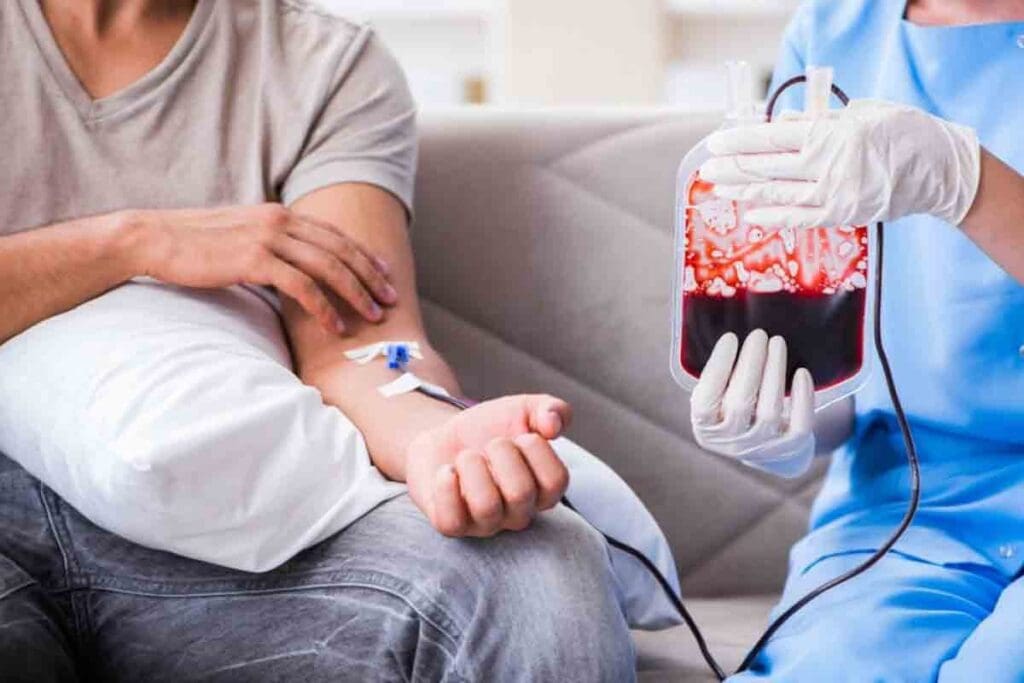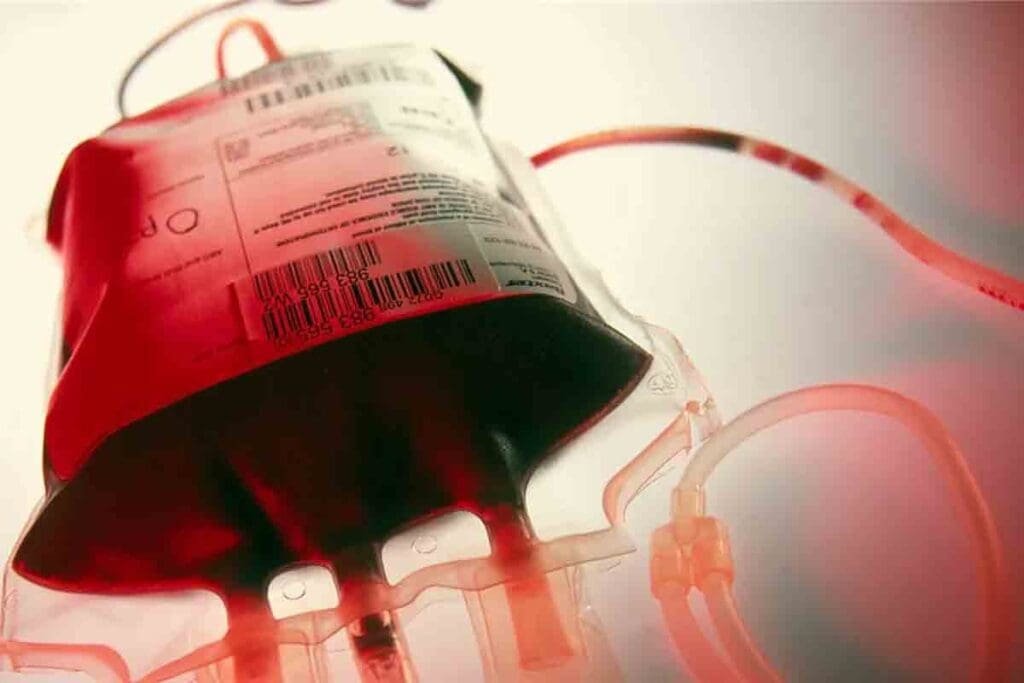Last Updated on November 17, 2025 by Ugurkan Demir

Millions of people worldwide face life-threatening diseases. These diseases need blood transfusions to survive and recover. There are many therapies to manage these conditions, like medication, transfusions, and new approaches.
Liv Hospital is a top place for the blood disorder treatment. They set high standards in healthcare worldwide. It’s important to know about the different therapies to help patients get better.

It’s important to know how blood transfusions work in medicine. They involve giving donated blood or blood parts through a vein. This is done with a thin tube.
A blood transfusion is when blood or its parts are given to someone. It’s to replace lost blood or to help carry oxygen better. It’s key to treating many health issues.
These include sickle cell disease, thalassemia, aplastic anemia, leukemia, and myelodysplastic syndromes. Blood transfusions can ease symptoms and prevent problems. They can also make life better for those with these conditions.
Doctors decide if a transfusion is needed based on the patient’s health and how sick they are.
Blood has different parts, each with its own job. The main parts used in transfusions are:
The type of component given depends on what the patient needs. For example, someone with severe anemia might get red blood cells to help tissues get oxygen.
Intravenous blood transfusions give blood or its parts directly into a vein. This is done through an intravenous line. It’s a careful process to avoid bad reactions.
Healthcare teams watch for signs of a reaction, like fever or rash. They adjust the transfusion rate based on how the patient is doing and what’s being given.
In summary, blood transfusions are a critical part of medical care. They help patients with many blood-related issues. Knowing how they work helps doctors make them more effective.

Blood disorder treatment includes many strategies to manage and cure blood diseases. The right treatment depends on the disease, its severity, and the patient’s health.
Medicines are key in treating blood disorders. For example, anticoagulants stop blood clots, and clotting factors help those with hemophilia. Immunosuppressive drugs are used to stop the immune system from attacking the bone marrow in cases like aplastic anemia.
New medicines for blood diseases are being developed. These new agents are safer and work better. Targeted therapies that focus on specific blood cancer mechanisms are becoming more common.
Transfusion therapies give blood components to replace or add to a patient’s blood. This can include red blood cells, platelets, or plasma. Regular transfusions save lives for those with conditions like thalassemia major.
A leading hematologist says, “Transfusion therapy is key in managing blood disorders. It provides essential components that the body can’t make enough of.”
“Better blood screening techniques have made transfusions safer. This has lowered the risk of infections from blood transfusions.”
Bone marrow or stem cell transplantation can cure some blood disorders, like leukemia and aplastic anemia. This involves replacing the patient’s diseased bone marrow with healthy stem cells from a donor.
| Condition | Treatment Approach | Potential Outcomes |
| Thalassemia Major | Regular Blood Transfusions, Chelation Therapy | Improved Quality of Life, Reduced Complications |
| Hemophilia | Clotting Factor Replacement | Reduced Bleeding Episodes, Improved Joint Health |
| Aplastic Anemia | Immunosuppressive Therapy, Stem Cell Transplantation | Potential Cure, Improved Blood Counts |
Research into blood disorders is ongoing. Gene therapy is being explored for conditions like sickle cell disease and beta-thalassemia. It aims to fix the genetic defect.
Emerging treatments aim to manage symptoms and address the root causes of blood disorders. They offer the chance for cures or better management for patients.
Sickle cell disease is a hereditary condition that affects hemoglobin. It requires careful management to prevent severe complications. Blood transfusions are often needed to manage its acute and chronic issues.
Sickle cell disease comes from a mutation in the HBB gene. This leads to abnormal hemoglobin, known as sickle hemoglobin or HbS. Red blood cells then take on a sickle shape, leading to their early destruction.
This early destruction causes various symptoms. These include episodes of pain, known as crises, anemia, infections, and possible organ damage over time. The severity and frequency of these symptoms vary among patients.
Blood transfusions are key in managing sickle cell disease. They reduce the number of red blood cells that can sickle. Regular transfusions help prevent crises and lower the risk of complications.
Transfusion protocols involve regular checks to see if a transfusion is needed. These checks look at hemoglobin levels, crisis history, and organ damage signs. Depending on the situation, simple or exchange transfusions are used.
Along with transfusions, other medications and therapies help manage sickle cell disease. Hydroxyurea, for example, can reduce the number of painful crises. Pain management medications are also used.
Supportive care, like vaccinations against infections, is also important. New therapies, like gene therapy, offer hope for future cures.
Thalassemia is a genetic disorder that affects how the body makes hemoglobin. It often requires regular blood transfusions to manage its effects. This condition leads to insufficient hemoglobin production, causing severe anemia and other issues. Blood transfusions are key to keeping thalassemia patients healthy and improving their quality of life.
Several types of thalassemia need regular blood transfusions. Beta-Thalassemia Major, also known as Cooley’s Anemia, is the most severe. It results in very low or no production of beta-globin chains of hemoglobin.
The frequency of blood transfusions varies based on the patient’s condition and treatment plan. Transfusions are given regularly to keep hemoglobin levels above 9-10 g/dL. This ensures enough oxygen reaches tissues and organs. The goal is to suppress erythropoiesis and reduce disease complications.
Regular blood transfusions can cause iron overload, where too much iron builds up in the body. This can harm vital organs like the heart and liver. To prevent this, thalassemia patients often get chelation therapy. This treatment uses medications to remove excess iron from the body. Managing iron overload is vital to avoid long-term damage and improve patients’ lives.
Aplastic anemia is a rare and serious condition. It happens when the bone marrow can’t make enough blood cells. This requires quick medical help and a detailed treatment plan.
Aplastic anemia can be caused by toxins, some medicines, viruses, and autoimmune diseases. Symptoms include tiredness, infections, and bleeding. This is because the body doesn’t have enough blood cells.
To diagnose it, doctors do a bone marrow biopsy. They look for a low cell count in the marrow. Blood tests also show a drop in red and white blood cells and platelets.
Transfusions are key in caring for aplastic anemia patients. They increase the number of blood cells. This helps with anemia and prevents bleeding.
Table: Transfusion Support in Aplastic Anemia
| Component | Purpose | Clinical Benefit |
| Red Blood Cells | Improve oxygen delivery | Reduces anemia symptoms |
| Platelets | Prevent or treat bleeding | Reduces risk of hemorrhage |
| White Blood Cells | Enhance immune response | Reduces infection risk |
Immunosuppressive therapy (IST) and stem cell transplantation are the main treatments. IST uses medicines to calm the immune system. This helps when the immune system attacks the bone marrow.
Stem cell transplantation, often from a sibling, can cure the disease. It replaces the patient’s bone marrow with healthy donor cells.
Choosing between an IST and a stem cell transplant depends on several factors. These include the patient’s age, how severe the condition is, and if a suitable donor is available.
Transfusion support is key in leukemia treatment. It helps reduce risks from the disease and its treatment. Leukemia is a blood cancer that often needs strong chemotherapy. This can cause a big drop in blood cells.
Patients with leukemia face a high risk of bleeding and infection. This is because of low platelets and white blood cells. Blood transfusions are vital in managing these risks. They help replace lost blood cells.
Patients receiving strong chemotherapy for leukemia need different blood products. These include red blood cells, platelets, and granulocytes. The exact needs depend on the patient’s health and the treatment plan.
It’s very important to manage bleeding and infection risks during leukemia treatment. Transfusions are a big part of this, along with other care.
Prophylactic platelet transfusions can stop bleeding problems. Granulocyte transfusions might be used for severe low white blood cells and infections that don’t get better with antibiotics.
“The use of blood component therapy has revolutionized the support of patients with leukemia, significantly improving outcomes by reducing the risks associated with chemotherapy.” –
A renowned hematologist
Pediatric and elderly patients need special care with transfusions during leukemia treatment. Their bodies and health issues are different, so they need special plans.
For kids, the goal is to avoid long-term problems and help them grow right. For older adults, it’s important to manage heart and kidney health. This is because they might have other health issues that affect how well they can handle transfusions.
| Patient Group | Special Considerations |
| Pediatric | Minimizing long-term complications, ensuring growth and development |
| Elderly | Managing cardiovascular and renal function, comorbidities |
Managing myelodysplastic syndromes (MDS) means weighing the good and bad of blood transfusions. MDS are disorders where blood cells don’t form properly, leading to a big need for transfusions.
MDS happens when the bone marrow can’t make healthy blood cells. This causes anemia, infections, and bleeding. It’s a big problem that needs help to fix.
People with MDS often get blood transfusions to fight anemia and prevent bad outcomes. But needing transfusions a lot can cause iron overload and other issues. It’s important to manage these risks to help patients live better.
| Aspect | Description | Impact on Patients |
| Transfusion Frequency | Regular transfusions to maintain hemoglobin levels | Increased risk of iron overload |
| Iron Chelation Therapy | Treatment to reduce iron overload | Improves long-term outcomes |
| Quality of Life | Management of symptoms and transfusion-related complications | Enhanced patient well-being |
New treatments like lenalidomide and hypomethylating agents aim to cut down on transfusions for MDS patients. These treatments might help make blood cell counts better and reduce the need for frequent transfusions.
Creating new ways to treat MDS is key to better patient care. By knowing the good and bad of current treatments and looking into new ones, doctors can give MDS patients better care.
People with hemophilia and other bleeding disorders need factor replacement to stop bleeding. Hemophilia makes it hard for the body to form blood clots. Clots are essential to stop bleeding.
Blood products for coagulation disorders include plasma-derived and recombinant factor concentrates. Recombinant factor products are made through genetic engineering. This method inserts the clotting factor gene into a host cell line.
This process greatly reduces the risk of passing on infectious agents. It makes factor replacement therapies safer.
Factor replacement therapy can be given on demand or regularly. On-demand treatment is used when someone bleeds. It involves infusing factor concentrates to stop the bleeding.
Prophylactic treatment is regular infusions to prevent bleeding. It’s a key part of managing severe hemophilia. It greatly improves the quality of life.
“Prophylactic factor replacement has revolutionized the management of hemophilia, turning what was once a debilitating condition into a manageable one.”
— Dr. Jane Smith, Hematologist
New advancements in recombinant factor therapy aim to improve how long factor products last. Extended half-life products stay effective for longer. This means less frequent dosing.
| Feature | Standard Half-Life | Extended Half-Life |
| Dosing Frequency | 2-3 times a week | Once a week or less |
| Factor Level Maintenance | Effective for 2-3 days | Effective for 4-5 days or more |
New technologies and treatment strategies are improving hemophilia and bleeding disorder management. They offer better outcomes and quality of life for patients.
Blood transfusions save lives but need strict safety rules. Keeping the blood safe is key to avoiding infections and bad reactions.
New blood screening methods have greatly improved. They use nucleic acid testing (NAT) and serological testing to find viruses and bacteria. This has made blood safer, almost infection-free.
NAT is key in finding viruses like HIV and hepatitis. It makes blood transfusions safer for everyone.
Even with careful screening, transfusion reactions can happen. These reactions can be mild or severe. Quick action is needed to avoid serious problems.
Doctors watch patients closely during transfusions. They act fast if something goes wrong. This includes stopping the transfusion and finding out why it happened.
Matching the donor’s blood with the recipient’s is vital. This includes ABO and RhD typing and checking for antibodies. It’s all about making sure the blood is safe.
Doctors also consider each patient’s needs. This includes checking for past transfusions or antibodies. New tests help avoid bad reactions.
| Safety Measure | Description | Benefit |
| Nucleic Acid Testing (NAT) | Detects viral genetic material in donated blood | Reduces the risk of viral transmission |
| Serological Testing | Identifies antibodies against viral antigens | Enhances detection of viral infections |
| Compatibility Testing | Ensures blood group compatibility between donor and recipient | Prevents hemolytic transfusion reactions |
It’s important for healthcare workers to know the difference between blood infusion and blood transfusion. These terms are often mixed up, but they mean different things for patient care.
Blood transfusion means putting blood or blood parts into a patient’s bloodstream for health reasons. This can be red blood cells, platelets, plasma, or other blood products. Blood infusion, though, is a wider term. It includes blood transfusions and also giving other IV fluids or medicines.
Key differences between blood infusion and transfusion:
Choosing between blood infusion and transfusion depends on the patient’s health. For example, someone with anemia or a big blood loss gets a blood transfusion. But if a patient needs hydration or certain medicines, they might get a blood infusion.
| Clinical Scenario | Recommended Approach |
| Severe anemia | Blood Transfusion (Red Blood Cells) |
| Dehydration | Blood Infusion (IV Fluids) |
| Bleeding disorder | Blood Transfusion (Platelets or Clotting Factors) |
Telling patients about blood infusion and transfusion is key for them to make informed choices. They need to know why they’re getting treatment, the risks, and the benefits.
In summary, blood infusion and transfusion are both important in healthcare. But knowing their specific uses helps doctors give better care. By matching treatment to patient needs, healthcare can lead to better results and care for patients.
Research into new treatments for blood disorders is ongoing. This progress has greatly improved how we manage these conditions. It has also made life better for those affected.
Many blood disorders, like sickle cell disease and leukemia, need a detailed treatment plan. Transfusions are key in managing these diseases. Scientists are working hard to make transfusions better and find new treatments.
New therapies and technologies are on the horizon. They promise to make patient care even better. As research grows, treatments will likely become more precise and effective.
Healthcare professionals can offer top-notch care by keeping up with the latest in blood disorder management. This helps patients live better lives and get the best treatment possible.
Blood transfusions help treat blood diseases and disorders. They replace or supplement blood components. This helps manage symptoms and improve quality of life.
Blood infusion and blood transfusion mean the same thing. They refer to the process of putting blood or blood components into a patient’s body. “Transfusion” is more common in medical settings.
Blood transfusions are done through an IV. They involve giving red blood cells, platelets, or plasma. The process is done in a hospital, with close monitoring of the patient.
Blood transfusions can cause reactions and infections. Modern screening has lowered infection risks. But reactions and iron overload are concerns, mainly for frequent transfusions.
No, blood transfusions don’t cure most blood diseases. They manage symptoms and improve life quality. For some, like hemophilia, regular therapy is needed. In cases like leukemia, transfusions support during chemotherapy.
Transfusions are key in sickle cell disease management. They help during crises and prevent complications. Regular transfusions reduce pain crises and stroke risk.
Schedules for thalassemia patients depend on the disease’s severity and hemoglobin levels. Regular transfusions keep hemoglobin levels up and prevent complications.
Chelation therapy removes excess iron in frequent transfusions patients. It prevents organ damage and complications from iron overload.
Yes, alternatives exist for some conditions. These include medications, stem cell transplants, or gene therapy. New treatments are being researched.
Patients can reduce risks by following their doctor’s advice and reporting symptoms. Sticking to scheduled transfusions is also important. Education and awareness are key to safe transfusions.
Subscribe to our e-newsletter to stay informed about the latest innovations in the world of health and exclusive offers!